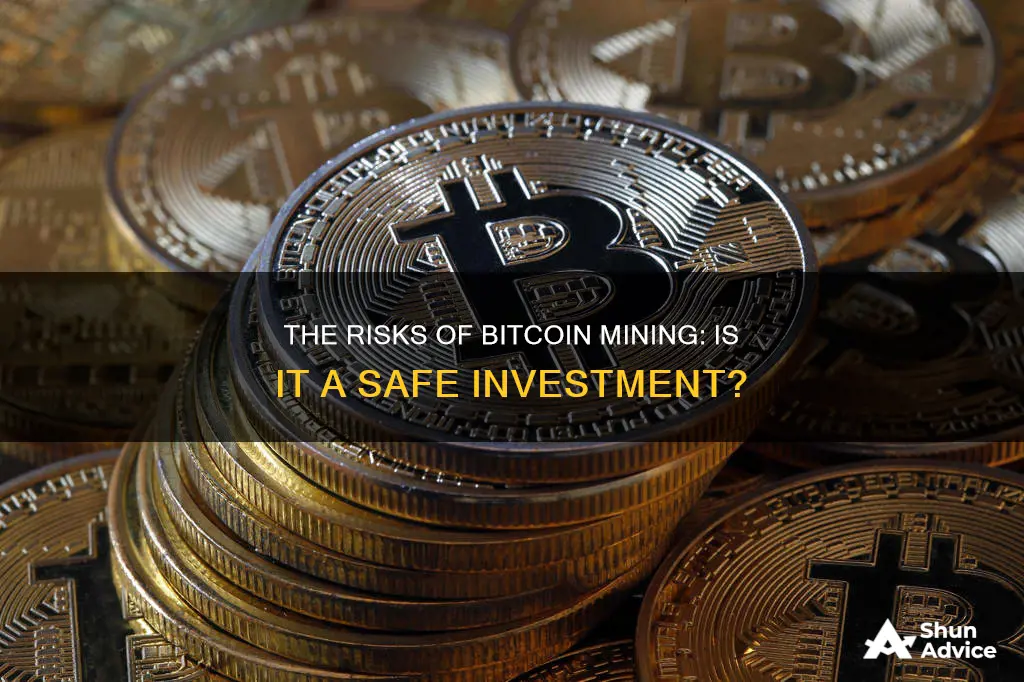
Bitcoin mining can be a lucrative endeavour, but it comes with significant financial risks and requires a large upfront investment. Bitcoin mining is the process of validating transactions and adding them to a public ledger called the blockchain. Miners compete to guess a complex 64-digit number known as a hash, and the first miner to find the solution receives bitcoins as a reward. The process requires substantial hardware and software, as well as a significant amount of electricity, which can result in high costs. The profitability of bitcoin mining depends on various factors, including the price of bitcoin, the hash rate, and the difficulty of the mining process. It is important to carefully consider the risks and costs before investing in bitcoin mining.
| Characteristics | Values |
|---|---|
| Potential for profit | Cryptocurrency prices are volatile, but mining a coin in high demand could result in a profitable sale. |
| Diversification | Cryptocurrency mining can be a way to diversify an investment portfolio. |
| Passive income | Once the mining rig is set up, it can generate passive income as long as it is running and mining a profitable cryptocurrency. |
| Set-up costs | It can be expensive to set up a crypto-mining operation due to the need to purchase specialised hardware, electricity costs and other overhead expenses. |
| Risk | The value of cryptocurrencies is volatile, and there is no guarantee that mined coins can be sold for a profit. |
| Energy consumption | Crypto mining requires a lot of computational power, which consumes a lot of electricity. |
| Competition | There are many people and organisations competing to mine cryptocurrencies, and the difficulty of the mining process can increase over time. |
What You'll Learn

Bitcoin mining profitability
Bitcoin mining can be profitable, but it is a high-risk, high-reward activity that may not be suitable for everyone. There are several factors to consider when determining the profitability of Bitcoin mining:
- Cost of the mining device: Quality ASICs range from about $1,000 to more than $15,000. GPUs and CPUs are cheaper but less powerful and less profitable for Bitcoin mining.
- Hash rate: The number of hashes per second the mining device can generate. A higher hash rate means more profit.
- Efficiency: The amount of energy a mining device requires, expressed in watts per terahash (W/TH). A more efficient device will cost less to run.
- Electricity costs: The price of electricity is a major factor in the profitability of Bitcoin mining. Cheap electricity is essential to making money from Bitcoin mining.
- Price of Bitcoin: Bitcoin is extremely volatile, and mining profits will rise or fall with its price movements.
There are several online mining profitability calculators that can help determine how much passive income can be expected from Bitcoin mining. These calculators take into account the hash rate, efficiency, and electricity costs of a mining operation.
The biggest risk of Bitcoin mining is that the start-up costs may never be recouped. ASIC miners, which are necessary to have any chance of turning a profit, are expensive, with those possessing sufficient processing power costing at least $1,000. Even with an ASIC miner, it can take over a year to turn a profit, and mining devices often become obsolete within three years.
Other risks of Bitcoin mining include the environmental impact of the energy consumption and the safety hazards posed by the substantial electricity usage.
Is Bitcoin Too Pricey to Invest in Now?
You may want to see also

Bitcoin mining legality
The legality of Bitcoin mining varies across the world. In many jurisdictions, Bitcoin mining is legal. However, there are still some countries where it is illegal.
In North America and Western Europe, Bitcoin is relatively accepted by legal authorities, and some laws have been passed to better define its legal status. In many places, Bitcoin and Bitcoin mining are legal by default, as no law has been passed to determine its legality.
Bitcoin mining is illegal in places where the government directly opposes Bitcoin because of its ability to compete with the national currency, undermine the government's authority, or due to misunderstandings about the technology. For example, in 2013, the Central Bank of Nigeria (CBN) banned bank transactions in Bitcoin and other virtual currencies. In 2014, the Central Bank of Bolivia issued a resolution banning Bitcoin and any other currency not regulated by a country or economic zone.
Other countries have a more complex relationship with Bitcoin. For instance, while Bitcoin mining is legal in the United States, the Internal Revenue Service (IRS) considers cryptocurrency mining to be taxable by law, and any income generated through mining operations is subject to federal income tax.
The map of places that have outlawed Bitcoin mining is constantly evolving, and it is important to research the legal status of Bitcoin mining in your jurisdiction before investing in mining equipment.
Gold Coin Investment: Safe Haven or Risky Bet?
You may want to see also

Bitcoin mining environmental impact
Bitcoin mining has a significant environmental impact. The process is energy-intensive, requiring vast amounts of computing power to validate transactions and blocks. This energy consumption results in carbon emissions, with about half of the electricity used generated through fossil fuels.
Bitcoin mining is a proof-of-work process, where miners run dedicated software to compete and be the first to validate transactions and blocks. The process is highly electricity-intensive, with miners requiring powerful computers and specialised hardware to compete. The energy consumption of bitcoin mining is estimated to be between 95.5 TWh and 140 TWh annually, representing 0.4% to 0.63% of the world's electricity consumption. This is more energy than is used by some small countries and is comparable to the consumption of Belgium or the Netherlands.
The energy used to power bitcoin mining results in significant carbon emissions. One study estimated that bitcoin mining resulted in annual carbon emissions of 65 Mt CO2, representing 0.2% of global emissions, comparable to the emissions of Greece. Another study estimated that bitcoin mining produced 85.89 MtCO2E from 2020 to 2021, equivalent to the consumption of 9,665 gallons of gasoline by passenger vehicles or 96,210 pounds of coal burned in a year.
The environmental impact of bitcoin mining is further exacerbated by the short lifespan of specialised computer hardware, resulting in electronic waste. Bitcoin mining generates approximately 72,500 to 77,000 tons of electronic waste annually, comparable to the amount of waste produced by the Netherlands.
To reduce the environmental impact of bitcoin mining, a transition to the proof-of-stake protocol has been proposed. This protocol has better energy efficiency and could potentially reduce the carbon emissions associated with bitcoin mining. However, bitcoin advocates oppose such a change, arguing that proof of work is necessary to secure the network.
The environmental impact of bitcoin mining has attracted the attention of regulators and led to incentives or restrictions in various jurisdictions. Some countries, like China, have banned bitcoin mining due to its environmental concerns, while other states in the US, such as Iowa, Kentucky, and Texas, encourage bitcoin mining with tax breaks.
Bitcoin Investment: Safe or Risky Bet?
You may want to see also

Bitcoin mining equipment
Types of Mining Hardware
There are several types of cryptocurrency mining hardware, each with its own advantages and disadvantages.
- ASIC (Application-Specific Integrated Circuit) Miners: These are specialised devices designed specifically for mining a particular cryptocurrency. ASIC miners are the most powerful option for Bitcoin mining and offer the highest hash rates. However, they can be very expensive, often costing thousands of dollars. Examples include the Antminer S19 Pro, the AvalonMiner 1246, and the Dragonmint T1.
- GPU Mining Rigs: GPU mining uses one or more graphics cards to mine crypto. This type of mining is costly upfront due to the need to purchase high-end graphics cards. While popular for mining other types of cryptocurrency, GPU mining rigs lack the power needed for Bitcoin mining.
- CPU Mining: CPU mining uses a computer's central processing unit, making it the most accessible method as it only requires a computer. However, CPUs do not have enough processing power to compete with ASICs for Bitcoin mining.
- Cloud Mining: Cloud mining involves renting mining hardware from a third-party provider and paying them to mine crypto for you. This option can be good for those who cannot afford the upfront costs of purchasing and setting up their own mining hardware. However, cloud mining comes with risks, such as the possibility of scams.
Factors to Consider When Choosing Mining Hardware
When selecting Bitcoin mining hardware, there are several factors to consider:
- Hash Rate: The hash rate is the number of intensive mathematical operations the hardware can perform. A higher hash rate increases the likelihood of solving the next block in the Bitcoin blockchain and earning rewards.
- Power Consumption: Bitcoin mining hardware consumes a significant amount of electricity, so it is important to consider the power consumption of the hardware and the cost of electricity in your region.
- Noise Levels: Bitcoin mining hardware can be very noisy, so if you plan to set up your mining operation at home, choose hardware with lower noise levels.
- Efficiency: The efficiency of the mining hardware will impact your overall profitability. More efficient hardware will generate more Bitcoin with less electricity consumption.
- Price: Bitcoin mining hardware can range from a few hundred to several thousand dollars. It is important to consider your budget and the potential profitability of the hardware.
Bitcoin Wallets: Your Investment Companion?
You may want to see also

Bitcoin mining pools
There are several types of mining pools, each with its own set of advantages and disadvantages. Here are some of the most common types:
- Proportional mining pools: In this type of pool, miners send shares of work to the pool until it finds a block. The rewards are then distributed proportionally to the number of shares submitted by each miner.
- Peer-to-peer mining pools: These pools aim to prevent centralization by integrating a separate blockchain related to the pool itself. They are designed to prevent cheating by pool operators and ensure that the pool does not fail due to a single central issue.
- Full-Pay-Per-Share (FPPS): This is a payout method where miners are paid for the shares or blocks they contribute to the pool.
- Pay-Per-Share-Plus (PPS+): In this method, miners receive a proportional amount of the reward based on the quality of the shares they provided, and the pool also pays a transaction fee reward.
- Pay-Per-Last-N-Shares (PPLNS): When a block is found, the pool software locates the last blocks contributed by each miner after the last winning block. The number of trial blocks or shares contributed between that time determines the payout. This usually requires miners to stay connected to the pool until a block is found, or they may lose their contributions and payout.
When choosing a mining pool, it is important to consider the payout scheme and the transparency of the pool's operations. The bigger and faster the pool is, the more likely you are to receive rewards, up to a certain point. Additionally, some mining pools may charge for their services, so it is important to understand their requirements before joining.
According to Blockchain.com, a few mining pools—AntPool, Foundry, ViaBTC, F2Pool, and Binance Pool—dominate the Bitcoin mining process. While many pools strive for decentralization, these groups have consolidated much of the Bitcoin blockchain. This centralization goes against the intended decentralized structure of Bitcoin and other cryptocurrencies.
Teen's Guide to Bitcoin: Getting Started with Crypto
You may want to see also
Frequently asked questions
Bitcoin mining is legal in some countries, but not in others. It is also a risky investment that requires a lot of upfront capital and has no guaranteed returns.
Bitcoin mining is the process of validating transactions and adding them to a public ledger called the blockchain. Miners compete to guess a complex 64-digit number known as a hash, and the first one to guess correctly receives a reward in bitcoin.
Pros: It can be an exciting way to earn money, and miners contribute to the bitcoin ecosystem by validating transactions and putting new coins into circulation.
Cons: It is expensive to set up and run, there are no guaranteed returns, and it has a negative environmental impact due to its high energy consumption.
First, you'll need to set up a digital wallet that accepts bitcoin. Then, you'll need to invest in bitcoin mining software and hardware, such as an ASIC or GPU mining rig. Finally, you'll need to solve complex algorithm puzzles to validate transactions and add blocks to the blockchain.







